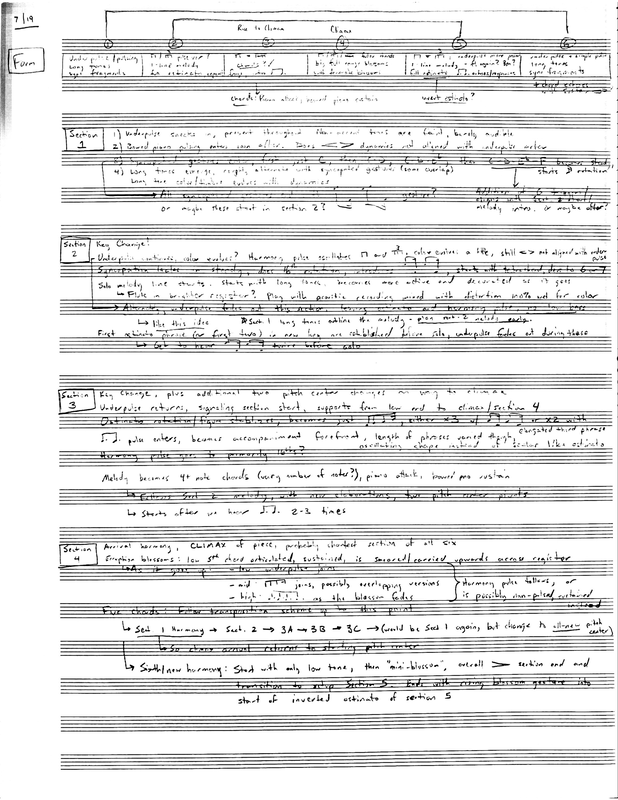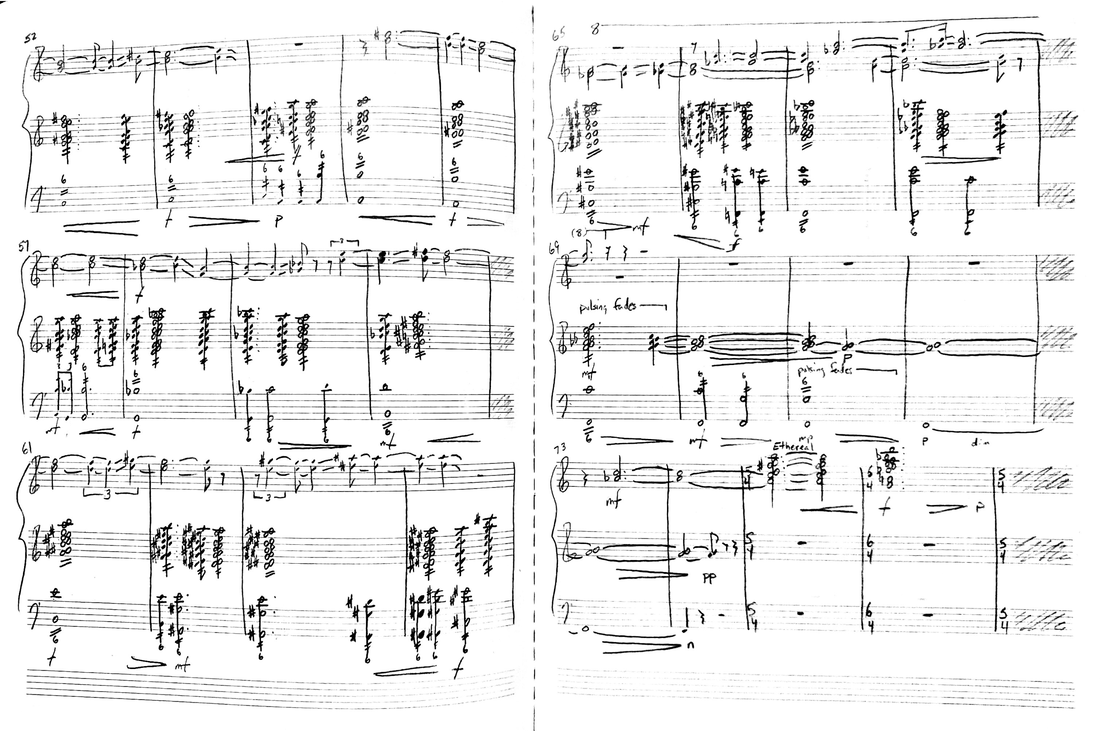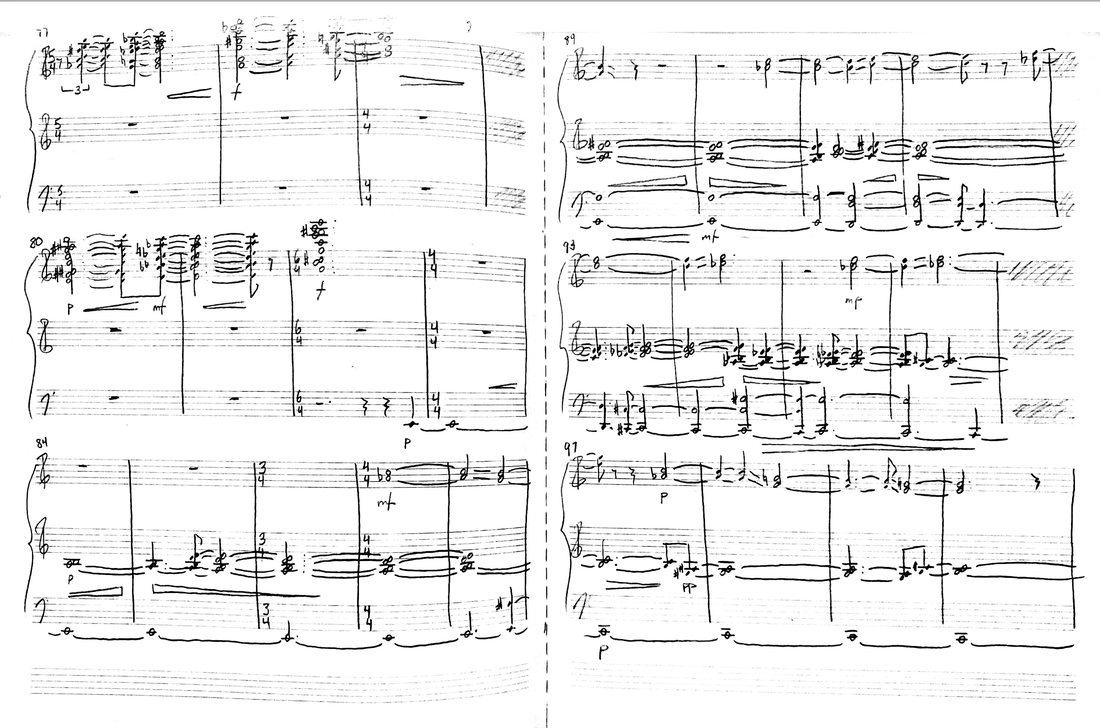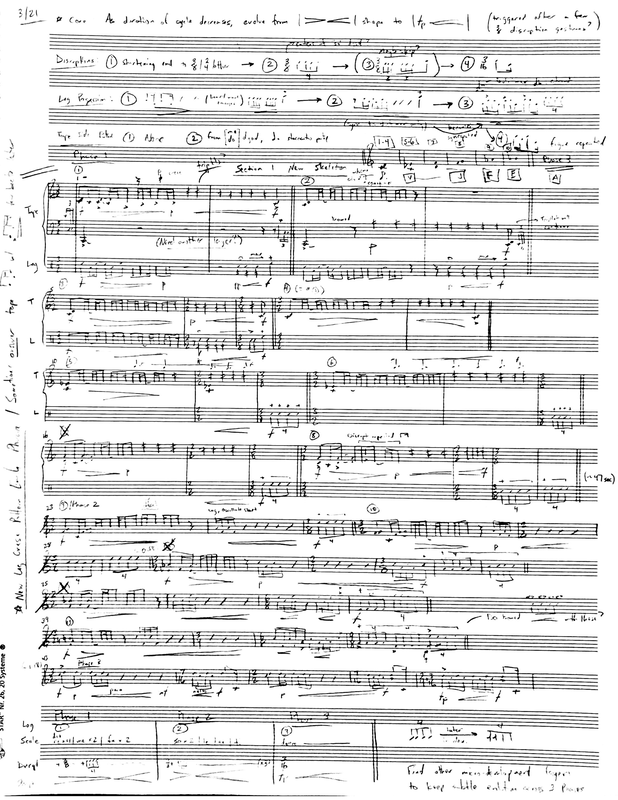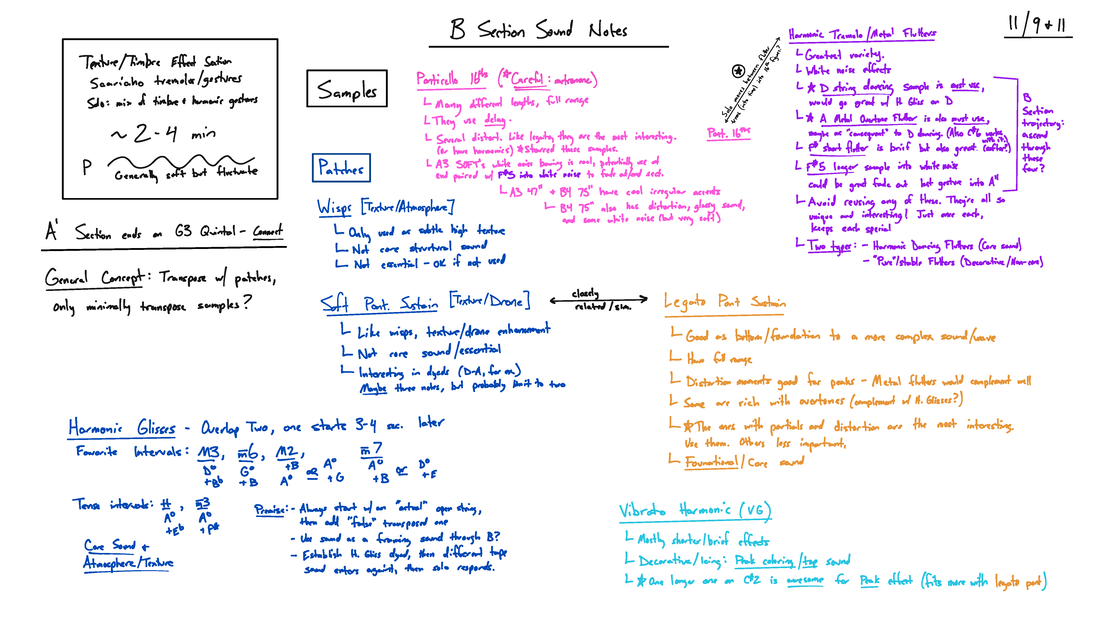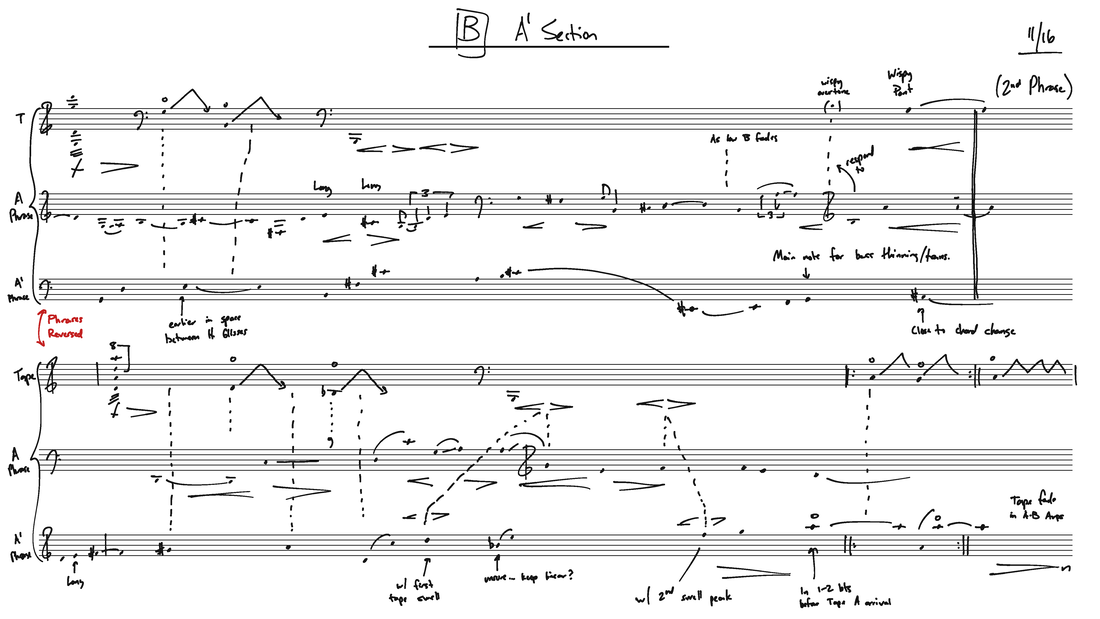Hypernova (2020)
for percussion and electronics
In outer space, a hypernova is a type of stellar explosion which ejects material with unusually high kinetic energy, an order of magnitude higher than most supernovae. Hypernova for percussion solo and electronic playback is centered on broad, explosive gestures that give birth to sparkling, virtuosic phrases.
The soloist plays a small kit of vibratone, five tuned gongs, tamborim, hi-hat, and kick drum, and the accompanying electronic part is made entirely of acoustic hand-stopped and bowed piano samples that were recorded, shaped, and assembled as digital instruments. There are four main types of these samples used throughout the piece:
The soloist plays a small kit of vibratone, five tuned gongs, tamborim, hi-hat, and kick drum, and the accompanying electronic part is made entirely of acoustic hand-stopped and bowed piano samples that were recorded, shaped, and assembled as digital instruments. There are four main types of these samples used throughout the piece:
- Piano with the string hand-muted and the pedal up. The most agile tape parts are primarily made with these sound samples.
- Piano with the string hand-muted and the sustain pedal down. Most low, resonant tones and some mid-range notes use these samples.
- Bowed piano, modified with post-production effects to give it an organ-like quality.
- Hand-muted, no-pedal piano samples with the envelope reversed to play backwards as a swell gesture. You hear this sound at the very beginning of the piece.
Sketches and Manuscript Excerpts
Lighting Sequence
Echo (2021)
for flute and electronics
Echo for flute and electronics is a lyrical and expressive solo. The title reflects reverberant gestures that appear throughout the piece in many forms. In the beginning of the work, these “echo” gestures begin with a burst of sound and fade into the distance while the flute soars gracefully above them. Later in the work, these gestures evolve and are more literally echoed through imitation. The electronic accompaniment for Echo is created from samples of muted piano, piano strings struck with sticks, chimes, string instruments, flutes, and bowed piano samples modulated with granular synthesis to produce pulsing effects.
The piece follows an ABA form. The A sections feature legato flute solo lines over a repeating rhythmically uneven rising scalar gesture. The B section features a clockwork-like rhythmic motor supporting a continuously evolving lyrical solo line. The return to the A material sets up a beautiful yet haunting and mysterious conclusion.
The piece follows an ABA form. The A sections feature legato flute solo lines over a repeating rhythmically uneven rising scalar gesture. The B section features a clockwork-like rhythmic motor supporting a continuously evolving lyrical solo line. The return to the A material sets up a beautiful yet haunting and mysterious conclusion.
Sketches and Manuscript Excerpts
Lighting Sequence
Redshift (2023)
for percussion duo and electronics
In astronomy and cosmology, distant light sources show an increase in wavelength known as redshift. As light travels to us from a distant star, the space between us and the star is constantly expanding, stretching the wavelength of the light and shifting it towards the red end of the visible light spectrum. Redshift is visible in most of the light sources in our galaxy and is central to our understanding that the universe is expanding.
Redshift for percussion duo and electronics is a piece about push and pull. The piece revolves around three main types of material. The opening of the piece begins with type A: a series of explosive metallic chords that leave behind a syncopated rhythmic residue anchored by an uneasy piano pulse. As if sparked into motion, the percussionists dance around the piano pulse, creating momentum and drive into each subsequent explosion. Type B follows in the second major section of the piece and is characterized by a low, driving, and insistent piano motive, aggressive tutti scoring in the percussion duo, and frequent shifts in the length of ideas. The sense of drive is periodically interrupted by propulsive crescendos that allude to the type A material from the previous section. The third and middle section of the piece features the calmer, cooler atmosphere of type C. The duo plays an expanding and contracting rhythmic pattern in hocketed alternation throughout this section, as if looking to reignite the spark of energy that started the piece. The second half of Redshift is centered on development and interaction of the A and B materials as it approaches its explosive conclusion.
Redshift is scored for a small open instrumentation multi-percussion setup of two woods, two metals, two snare-like "pop" sounds, two low drums, and a shared bass drum. The electronics for Redshift are made primarily from gamelan, gong, and muted piano samples that are complemented by additional metallic percussion sounds and pulsing effects. Redshift was written for Quey Percussion Duo and was completed and premiered in 2023.
Redshift for percussion duo and electronics is a piece about push and pull. The piece revolves around three main types of material. The opening of the piece begins with type A: a series of explosive metallic chords that leave behind a syncopated rhythmic residue anchored by an uneasy piano pulse. As if sparked into motion, the percussionists dance around the piano pulse, creating momentum and drive into each subsequent explosion. Type B follows in the second major section of the piece and is characterized by a low, driving, and insistent piano motive, aggressive tutti scoring in the percussion duo, and frequent shifts in the length of ideas. The sense of drive is periodically interrupted by propulsive crescendos that allude to the type A material from the previous section. The third and middle section of the piece features the calmer, cooler atmosphere of type C. The duo plays an expanding and contracting rhythmic pattern in hocketed alternation throughout this section, as if looking to reignite the spark of energy that started the piece. The second half of Redshift is centered on development and interaction of the A and B materials as it approaches its explosive conclusion.
Redshift is scored for a small open instrumentation multi-percussion setup of two woods, two metals, two snare-like "pop" sounds, two low drums, and a shared bass drum. The electronics for Redshift are made primarily from gamelan, gong, and muted piano samples that are complemented by additional metallic percussion sounds and pulsing effects. Redshift was written for Quey Percussion Duo and was completed and premiered in 2023.
Form Diagram Sketch
Lighting Sequence
Howl (2021)
for saxophone improvisation and electronics
Howl is the product of an improvisatory collaboration between Eric and saxophonist David Pope. In May 2021, Eric and Dave recorded a solo sax improvisation session. Eric then selected three short sound clips from the session and developed them into three digital instruments using granular synthesis:
Eric composed the score while in residence at the Helene Wurlitzer Foundation of New Mexico in June 2021.
- Howls: an eerie sustained major third made from a tenor saxophone multiphonic. The howl lines are frequently pitch-bent to create the characteristic melodic gesture of the electronic part.
- Butterflies: a gentle, randomly oscillating major second interval made from a recording of an alternating tone and the “howl” major third multiphonic.
- Drones: a deep, rumbly drone sound made from a raspy low sustained tenor saxophone note subtle timbral variation. This sound is frequently modulated, bringing upper partials in and out of the texture.
Eric composed the score while in residence at the Helene Wurlitzer Foundation of New Mexico in June 2021.
Manuscript Excerpts
Lighting Sequence
Glitch (2021)
for percussion and electronics
GLiTCH is a piece about disruptions and tension. It begins with stable, consonant, and welcoming gestures, but these are gradually corrupted and interrupted by “glitches” that undermine the listener’s sense of stability and comfort. Rhythmic manipulation provides the primary means for disruption, but considerable tension also arises between harmonic consonance and dissonance as well as timbral relaxation and abrasiveness. The piece unfolds like a battle between the two opposing forces of stability and instability.
GLiTCH develops across six sections that are roughly palindromic in their sequence. The first section introduces the piece’s principal gestures, which then gradually become corrupted by increasingly unpredictable rhythmic glitches that truncate or prolong each gesture. Section two introduces a new groove driven by a steady bass ostinato, but this too is soon disrupted by a new, more dramatic glitch as a series of uneven mixed meter changes create interruptive counterpoint to the new groove. The tension arising from these two combative forces peaks in the third section, where the rhythmic and harmonic instability is cranked to the max in a forceful and dizzying array of highly varied syncopated gestures.
After the third section eventually collapses under the weight of its extreme tension, the fourth section treats us to respite and stability as the music gently coasts over a series of slowly shifting consonant harmonies that revisit and amplify the stability of the opening section. This stability is short lived though, as the fifth section bursts in with another surge of disruptive syncopations and gives way to the reappearance of the second section’s ostinato groove. The groove again battles its way through mixed meter interruptions to a climactic sixth and final section that revisits, elevates, and celebrates the piece’s opening gestures, but even this celebration can’t quite shake the glitches that have intruded from the very beginning.
The electronic accompaniment for GLiTCH is created from samples of hammered dulcimer, log drums, and piano strings played with sticks. The hammered dulcimer and log drum samples are also processed with a granular synthesizer to create the synthetic pulsating and rhythmic sounds that complement the acoustic samples at the forefront of the music’s texture.
GLiTCH develops across six sections that are roughly palindromic in their sequence. The first section introduces the piece’s principal gestures, which then gradually become corrupted by increasingly unpredictable rhythmic glitches that truncate or prolong each gesture. Section two introduces a new groove driven by a steady bass ostinato, but this too is soon disrupted by a new, more dramatic glitch as a series of uneven mixed meter changes create interruptive counterpoint to the new groove. The tension arising from these two combative forces peaks in the third section, where the rhythmic and harmonic instability is cranked to the max in a forceful and dizzying array of highly varied syncopated gestures.
After the third section eventually collapses under the weight of its extreme tension, the fourth section treats us to respite and stability as the music gently coasts over a series of slowly shifting consonant harmonies that revisit and amplify the stability of the opening section. This stability is short lived though, as the fifth section bursts in with another surge of disruptive syncopations and gives way to the reappearance of the second section’s ostinato groove. The groove again battles its way through mixed meter interruptions to a climactic sixth and final section that revisits, elevates, and celebrates the piece’s opening gestures, but even this celebration can’t quite shake the glitches that have intruded from the very beginning.
The electronic accompaniment for GLiTCH is created from samples of hammered dulcimer, log drums, and piano strings played with sticks. The hammered dulcimer and log drum samples are also processed with a granular synthesizer to create the synthetic pulsating and rhythmic sounds that complement the acoustic samples at the forefront of the music’s texture.
Manuscript Excerpts
Lighting Sequence
(Each grey line represents either dimming or an individual color)
Apparition (2023)
for cello and electronics
Apparition is an expressive, ethereal piece for cello and electronics. While the piece does not have a programmatic narrative, its emotional core and otherworldly sound was shaped by the imagery of wishing to connect with a lost loved one and express previously unsaid feelings of love, longing, and regret. The piece floats freely out-of-time throughout its thirteen minute duration, and the evolution of its delicate and feathery texture represents the emotional journey of one reflecting on a beloved, lost relationship.
Apparition unfolds across three broad sections. The piece beings with the cello playing gentle harmonic oscillations that are echoed by the electronics. Both parts flow and weave together in a lush, growing tapestry until the cello breaks free into a passionate, lyrical melody as the electronics continue with blossoming waves. In the second major section of the piece, the electronics shift from flowing waves to wispy tremolos, harmonic glissandos, and metallic fluttering. The cello plays a mysterious lament against this backdrop and later plays long, high harmonic tones in alternation with the electronics, as if sending out a signal to the beyond and hoping for a reply. The third major section returns to the wave-like oscillations of the first and reaches new emotional heights before fading into an airy coda that lingers beyond the conclusion of the piece.
The electronics for Apparition are made entirely from cello samples recorded with Carl Donakowski in the fall of 2023. These samples include a multitude of individual harmonics, arpeggiated harmonic gestures, and improvised timbre manipulation on repeated notes and long tones. Apparition was written for Carl Donakowski in 2023, and today’s performance in the world premiere.
Apparition unfolds across three broad sections. The piece beings with the cello playing gentle harmonic oscillations that are echoed by the electronics. Both parts flow and weave together in a lush, growing tapestry until the cello breaks free into a passionate, lyrical melody as the electronics continue with blossoming waves. In the second major section of the piece, the electronics shift from flowing waves to wispy tremolos, harmonic glissandos, and metallic fluttering. The cello plays a mysterious lament against this backdrop and later plays long, high harmonic tones in alternation with the electronics, as if sending out a signal to the beyond and hoping for a reply. The third major section returns to the wave-like oscillations of the first and reaches new emotional heights before fading into an airy coda that lingers beyond the conclusion of the piece.
The electronics for Apparition are made entirely from cello samples recorded with Carl Donakowski in the fall of 2023. These samples include a multitude of individual harmonics, arpeggiated harmonic gestures, and improvised timbre manipulation on repeated notes and long tones. Apparition was written for Carl Donakowski in 2023, and today’s performance in the world premiere.
Sketch and Sound Design Excerpts
Lighting Sequence
Artist Biographies
Eric GuinivaN
|
Eric Guinivan’s music has been performed by orchestras, chamber ensembles, and soloists across the United States, Europe, and Asia. His works have received notable honors from BMI, ASCAP, the American Academy of Arts and Letters, the Theodore Presser Foundation, and Meet the Composer. Eric has received commissions from Chamber Music America, the Fromm Foundation at Harvard University, New York Youth Symphony, the International Horn Society, the Firebird Ensemble, Staunton Music Festival, the Lotte Lehmann Foundation, and the Society of Composers, Inc., among others. His output includes works for orchestra, wind ensemble, brass band, chamber orchestra, film, percussion, and a wide variety of chamber ensembles and solo instruments.
Eric’s music has been featured at numerous international festivals and conferences, including Cello Biennale Amsterdam, the Banff International String Quartet Competition, Melbourne International Chamber Music Competition, the College Band Director’s National Association National Conference, the Percussive Arts Society International Convention, the Royal Northern College of Music Brass Band Festival, the North American Brass Band Association National Championship, the International Trombone Festival, the International Tuba and Euphonium Conference, and the American Liszt Society Festival. A Grammy nominated percussionist, Eric was a founding member of Los Angeles Percussion Quartet and has performed with orchestras and chamber ensembles across the country. Eric made his Carnegie Hall debut in 2011 performing as soloist with the New York Youth Symphony in the premiere of his work Meditation and Awakening for percussion and orchestra. The New York Times subsequently described the work as "engaging," praising its "shimmering colors" and "frenetic energy." Eric has also performed as soloist with the Downey Symphony and the University of Southern California Thornton Symphony and regularly performs with the Shenandoah Valley Bach Festival and Staunton Music Festival in Virginia. Eric founded the new music website Composers Circle and curated the site from 2012 through 2016, featuring one composer and one piece every day. The site aimed to increase exposure for composers by sharing a wide range of recent recordings of new music with a broad audience. During its nearly five-year run of programming, it featured over 1,500 works by more than 900 composers from 30 countries, and the project was featured in an in-depth interview in the Society of Composers, Inc. newsletter in February 2015. To date, composers Circle has been viewed by more than 70,000 unique visitors from 160 countries. Eric received Bachelor of Music Degrees in Composition and Percussion Performance from Indiana University and holds Masters and Doctoral degrees in composition from the University of Southern California Thornton School of Music. Eric joined the faculty of the James Madison University School of Music in 2013 and is currently Associate Professor of Composition. |
mihir borah
Mihir Borah (they/he) is currently pursuing a BM in music composition at James Madison University under the instruction of Dr. Eric Guinivan and Dr. Jason Haney, and is also in Dr. Beth Chandler Cahill's flute studio.
Casey Cangelosi
|
Casey Cangelosi is commonly hosted world-wide by educational institutions, music festivals, and educational seminars. Casey has been a visiting guest artist in Italy, Germany, Costa Rica, Mexico, Argentina, Croatia, Sweden, Taiwan, and widely across the U.S. at events including the The Midwest Clinic and PASIC Showcase Concerts. Casey is a regularly commissioned composer called the "Paganini of Percussion" and "The voice of a new generation". Casey holds music degrees from Rice University, The Boston Conservatory, and Utah State University. Casey is endorsed by Majestic, Mapex, Innovative Percussion, Zildjian, Grover Pro Percussion, Remo, and Beiner Bags.
|
David Pope
|
Professor of Saxophone, David Pope has been on the faculty since 2000. He is the Distinguished Teacher of the College of Visual and Performing Arts for 2012-13. He holds degrees from the Eastman School of Music, the University of Massachusetts, Amherst, with additional studies at the University of Miami.
David has extensively trained as a classical and a jazz saxophonist and is an active composer and author. He has penned the regular column “Creative Jazz Improvisation” for Saxophone Journal since 1995. In demand as a performer and clinician, he has appeared at the World Saxophone Congress, North American Saxophone Alliance, College Band Directors National Association, and the Virginia Music Educators Association. He has presented masterclasses and recitals at the Eastman School of Music, University of Southampton, California State University, Fresno, University of Northern Colorado, University of Northern Iowa, University of Massachusetts, and Bucknell University. He has also been a featured artist at the New England Saxophone Symposium. The Pioneer Saxophone Quartet (with Lynn Klock, Angela Space, and George Weremchuk) has been in-residence at SUNY Oswego, James Madison University, the New England Saxophone Symposium, the Central Florida Sax Fest, and the University of Miami. They premiered new works at the World Saxophone Congress 2012, and the 2008 North American Saxophone Alliance Biennial Conference. Widely recognized for his unique work with multiphonics, David has recorded a CD for Open Loop Records and two masterclass CDs for Saxophone Journal. His writings are available from Hal Leonard, Dorn Publications, and Ex Tempore. He has additional recordings on Albany Records and Dazzle Recordings David Pope plays R. S. Berkeley “Virtuoso” saxophones and endorses Applied Microphone Technology. |
Carl Donakowski
|
Carl Donakowski pursues a international career in Europe, Asia, and the Americas. Early in his career he was a finalist in the Mendelssohn Competition in Berlin. Since then, his recital performances have been enjoyed at the Kennedy Center in Washington, D.C.; Merkin Hall in New York City; and aired on WQRS Detroit, WQXR New York, and Südwestfunk Baden- Baden. He has performed at the Manitou, Fontana, Staunton, Tanglewood, Blue Lake, and Beethoven music festivals. Mr. Donakowski has performed on four continents, most recently (2017) in Guangzhou, China. As a member of the Arcos Trio, he was awarded an Artistic Excellence grant from the National Endowment for the Arts to perform and record piano trios by Latin American composers on the Centaur label. Of his performances at the Fontana Festival a reviewer wrote “Cellist Carl Donakowski is ideally suited to perform these romantic works. His tone is rich in resonance and passionate in approach, displaying the big sound that could sustain a charming longing.”
Donakowski is Professor of Music (Cello and Chamber music) at the James Madison University School of Music in Harrisonburg, VA where he received the distinguished teaching award. For over a decade he was Artist-in-Residence at the Bay View Music Festival. He has served on the faculties of Central Michigan University School of Music and Alma College. He is a frequent presenter at the American String Teachers Association national conference and a contributor to American String Teacher. He served as president of the Michiana Cello Society and currently edits the Cello Forum for the Virginia String Teachers Association. Donakowski was a student of Janos Starker at Indiana University. He also studied with Timothy Eddy Gary Hoffman and William Pleeth. |
Special Thanks
Tom Carr, JMU Recording Engineer and Sound Designer, whose audio expertise made this recital possible.
Recordings
If you enjoyed the the program, you can hear Hypernova, Redshift, Howl, and Glitch on YouTube.
|
|
|





